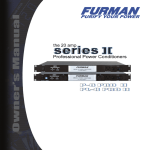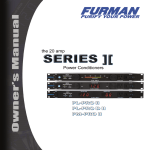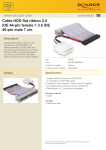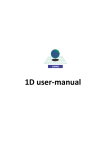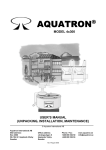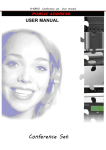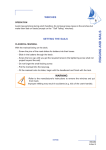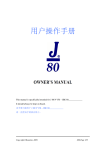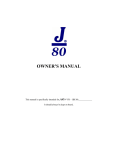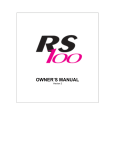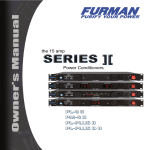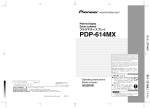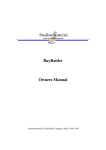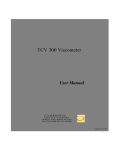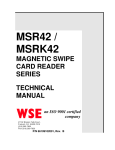Download Seascape18 Users Manual DRAFT – 01.05.2009
Transcript
Seascape18 Users Manual DRAFT – 01.05.2009 Seascape 18 user's manual **** DRAFT ***** page 1 1. Introduction Congratulations with your new Seascape 18. We hope you are going to enjoy sailing her as much as we enjoyed in her creation. Although she is very simple in concept, we believe that proces of discovering her potentials will give you plenty of satisfaction and fun for many years. 1.1. About this owner’s manual This manual has been compiled to help you operate your Seascape 18 with safety and as little complications as possible. It contains details of the boat and equipment fitted. Please read it carefully and familiarize yourself with the boat before using it. Please ensure that you are able to handle the boat in the anticipated wind and sea conditions before venturing out. This craft has been classified as a category C vessel, meaning a boat designed to operate in winds up to force 6 on the Beaufort scale and associated wave heights. This owner’s manual is not a course on boating safety or seamanship. If this is your first sport boat, or if you are unfamiliar with this concept of boats, please ensure you obtain handling experience before “assuming command” of the boat. Your dealer, National Sailing Federation or Yacht Club will be pleased to advice you of local sailing schools, or competent instructors. This owner’s manual is not a detailed maintenance or trouble shooting guide. In case of difficulties, always refer to Manufacturer or its proper representative. Always use trained and competent people for maintenance, fixing and modifications of your Seascape 18. Manufacturer cannot be held responsible for modifications they have not approved. Note also that any change in the disposition of masses aboard may significantly affect the stability, trim and performance of your boat. Users of the boat are advised that: • All crew should receive suitable training. • The boat should not carry more than the manufacturer’s recommended load. • Stability is reduced by any weight added high up. • Hatches must be closed and sealed and neoprene seal shall be fitted over main companionway to assure wattertightness of the interior. • Breaking wave are a serious stability hazard • Buoyancy aids are recommended to wear at all times by all crew for their own safety. In some countries, a driving licence or authorisation may be required, or specific regulations might apply. Please familiarize yourself with these. Always maintain your boat properly and make allowance for the deterioration that will occur in time and as a result of heavy use or misuse of the boat. Any boat, how strong it may be, can be severely damaged if not used properly. This is not compatible with safe boating. Please keep this owner’s manual in a safe place and hand it over to the new owner when you sell the boat. Seascape 18 user's manual **** DRAFT ***** page 2 1.2. General information Manufacturer: ISSA d.o.o. Model: Seascape 18 Category C: A boat designed to operate on winds up to force 6 on the Beaufort scale and associated wave heights (significant waves up to 2 metres) Such conditions may be encountered on exposed inland water, in estuaries and in coastal waters in moderate weather conditions. A significant wave height is the mean height of the highest one third of the wave, which approximately corresponds to the wave height estimated by an experienced observer. Some waves will be double this height. Maximum Recommended Load: b x 4 b + luggage = max 345 kg. Specifications: Length (LH1) = 5,55 m Width (BH1) = 2,37 m Mast height (above the deck) = 7,4 m Main sail area = 14.5 m2 Jib area (optional) = 8,5 m2 Spinnaker area = 32 m2 Maximum draft = 1.500 mm with keel down Maximum draft = 160 mm with keel and rudders up Weight fully rigged = 470 kg Identification: Hull identification number on stern of each hull. 1.3. Information connected with the risk of flooding and stability 1.3.1. Loading advice Keep the total weight of provisions, miscellaneous equipment not supplied by the manufacturer and persons aboard below the Maximum Recommended Load and suitably distributed. 1.3.2. Openings in the hull Hatch on the foredeck deck, neoprene seal and inspection hatch on the stern must be sealed before leaving the shore. When storing the boat ashore, be sure to have the holes covered and it may be wise to leave the hatches open for ventilation purposes. 1.3.3. Stability. Stability of the boat is designed to compensate to all crew errors to including wind strenght of 4bf without excesive heeling. In wind forces 4-6bf missuse of asymetric spinnaker can cause heel in ecces of 45 degrees and in force 6bf or more even knock down (90-100deg heel of the boat). Mast is watertight and in combination with weighted keel helps the boat to right herself when spinnaker hallyard is released. Seascape 18 user's manual **** DRAFT ***** page 3 1.4. Recommendations and information for proper operation 1.4.1. Danger from overhead power lines and other obstacles When rigging and moving your boat, please look up and inspect the overhead area. Observe the location of overhead power lines and trees. These obstacles can damage your boat are potentially dangerous to yourselves. Remember that carbon fibre is electric conductor. 1.4.2. Towing on the water When towing is required, make sure that: • The tow rope is securely tied on the U bolt mounted on the vertical section of the bow. • The boat is towed at a low speed. • The tow line is fastened in such a way, that it can be released when under load • The tow line is of strechy material and sufficient length to manoeuvre safely. Seascape 18 user's manual **** DRAFT ***** page 4 2. Assembly 2.1. Glossary Aft: Back of the boat. Asymetric spinnaker: Asymetric nylon sail hoisted when sailing downwind. Bow: Front of the boat. Bowsprit: the pole, which extends from the bow to fly the asymetric spinnaker. Bobstay: dyneema rope that prevents bowsprit to bend up when fully extended. Batten: Thin strip which fits into a long narrow pocket in the sail. It will give the sail its shape. Boom: Spar at the foot of the sail. Cleat: Fitting used for holding / securing ropes. Clew: Lower most after-most corner of a sail. Downhaul: Rope to stretch the luff of the sail. Also referred to as Cunningham. Foot: Bottom edge of the sail. Forestay: Wire supporting the mast in the fore and aft direction. Gunwale: Outermost edge of the hull. Goose neck: A hinge fitting connecting the boom to the mast. Halyard: Rope used to lower or hoist sails Head: The top corner of the sail. Hound: Point where the stays are connected to the mast Jib: Front sail. Jib Sheet: Control rope for the jib. Leeward: The side of the boat the sails are set to when sailing. Leech: Trailing edge of the sail. Luff: Front edge of the sail. Main sheet: Rope controlling the position of the main sail. Mast rake: Angle of the mast to the hull. Mast step; Fitting on the boat where the mast is connected to the front beam. Pintel: Fitting on the transom and rudder used to hang. Rudder stock: Carrier of a rudder blade and has an arm to steer. Shackle: U-shaped metal strip with a pin to secure halyards etc. Shrouds: Wire supporting the mast in the lateral direction. Turnbuckle: Adjustable stay connector to chain plate. Stern: Back of the boat. Tack: Forward lower corner of the sail. Tiller: (Telescopic) rod connected to the cross bar to steer the boat. Transom: Flat vertical plane of the end of the hull. Windward: The side of the boat opposite to where the sails are set to when sailing. Seascape 18 user's manual **** DRAFT ***** page 5 2.2. Tools needed Your Seascape18 can be assembled without an expensive tool kit, but be advised to have ready with you the following tools: • • • • • • Electric tape, flat screwdriver, 6mm open spanner, pliers, teflon dry lubricant, knife (not on the photo) 2.3. Mast step 1: Take off the ropes/straps that were use to fix the mast during transport and position it further to the front of the boat to balance it. step 2: When assembling forestay make shure that pin of the furler is pointing away from the mast tube otherwise it will damage it. You tighten the pin with the pliers. Seascape 18 user's manual **** DRAFT ***** page 6 After you insert the pin and secure it with the safety splice. When you finish protect it with the electric tape. On the bottom part of the shrouds attach turnbuckles to the chainplates as shown on the next photo. After you insert the safety pin aplly generous ammount of electric tape to prevent the spinnaker sheets catching in the pin. Make shure that the turnbuckles are maximaly unwinded to allow raising of the mast: step 3: the hallyards: First prepare the asymetric spinnaker hallyard that will later help you to raise the mast. Seascape 18 user's manual **** DRAFT ***** page 7 Mainsail hallyard is next. It has 2:1 purchase so later you will need a shackle to attach it to the head of the mainsail: Then the jib hallyard. Make shure to make a knot connecting both ends to prevent the hallyard from falling out of the top furler when hoisting. After you finish the top of the mast should look something like that: Step 4: raising the mast. Before raising make shure all the hallyards and shrouds are set as correctly and that they are not tangled. Operation can be done by single person if you use some sort of support instead of the person standing in the back of the boat. It is much easier to do it by two people. Seascape 18 user's manual **** DRAFT ***** page 8 Remove the pin from the mast step and tape the swiveling cleats for hallyards to prevent them catching between the mast and the coachroof when raising the mast: Then you remove the mast from its support and move it towards the back of the boat: The person at the back uses his shoulder to support the weight of the mast and the person at the mast step alignes the mast with the mast foot. In order to help aligning the holes the person supporting the mast gently moves the mast few centimeters left and right. Then you insert the bolt into the mast step and secure it with the safety pin: Seascape 18 user's manual **** DRAFT ***** page 9 You raise the mast to its final position. Person from the back of the boat is raising the mast by hand and by walking towards the front, the other is collecting the asymetric spinnaker hallyard which is in the process replacing the forestay. Next step is attaching the forestay. You attach furler with the drum, to forestay chainplate. Tension the asymetric spinnaker hallyard as much as needed to insert the forestay into desired hole. 5th from the top is a good start before you start playing with the trim… Seascape 18 user's manual **** DRAFT ***** page 10 For the end ease the asymetric spinnaker hallyard and put some medium tension to the shrouds turning the turnbuckles: When raised top of the mast should look like something like that (you can find two mistakes on photo below: only one shroud is secured with electric tape and loop for forestay is not nicley aligned): Seascape 18 user's manual **** DRAFT ***** page 11 2.4. Boom Attaching boom to the mast: You use supplied screw to attach boom to the goosneck. Use pliers to gently tighten the nut on the axis screw. Outhaul: Lead the thicker outahaul line trough the cutout in the boom and further trorugh the cleam and block. Attach this rope to the thiner one (tie together the two lines – the knot is hidden in the boom) which you lead out trough the block at the end of the boom. You use 1:2 purchase when attaching outhaul line to the mainsail as shown on the photo: Seascape 18 user's manual **** DRAFT ***** page 12 Vang (kicker) First you attach the double block on the mast foot and lead the two composite shackles trough the holes. The system suplied is 1:12 purchase. In stronger wind (20-25+ knots) this system allowes significant force to be put to the boom so be advised that you can damage the boom if you overtension the vang in this conditions. The use of composite shackles is explained in following photos: Don’t cut the cascade lines before the system streches. When you are satisfied with the mobility of the boom (it has to move at least 10deg up and down from horizontal position) you can cut the lines to right length. Seascape 18 user's manual **** DRAFT ***** page 13 The finished system should look like that: Make shure that the loop around the boom that distributes the force of the vang, isn’t tangled and runs smoothly: Seascape 18 user's manual **** DRAFT ***** page 14 2.5. Sails Jib: You start with fixing the furling line. Make shure that you roll the whole line to the drum (only the knot sticking out of the cleat on the coachroof) so you are shure to have enough line when you furl the jib. Then you attach the trapeze block on the furler. This will serve as jib’s downhaul (cunningham). Attach the jib’s cunningham line to the top eye of the block: Seascape 18 user's manual **** DRAFT ***** page 15 You prepare the jib on the deck and attach the tack on the forestay ladder: Then attach both ends of the forestay to the top of the jib and zip up the jib halyard and the forestay. Hoist the jib and make a knot at the bottom of the jib hallyard that will create a loop for jib cunningham: Seascape 18 user's manual **** DRAFT ***** page 16 Attach two jib blocks to the clew and run trough the jib sheets:¸ Gennaker: You begin by attaching the gennaker retrieving bag to the aluminium loop. Then attach the aft part of the bag to the U fitting behind the shroud chainplate where you’ll later attach the block for gennaker sheet. Then take the end of gennaker hallyard, run it trough the block on the left side of the cockpit (next to the gennaker sheet block) and trough the bag. Attach the sheet blocks: 40mm normal in the back and 40mm smart ratchet in the front Seascape 18 user's manual **** DRAFT ***** page 17 Make shure that ratchet is turned the right way (it should block the sheet towards the gennaker when under load). Attach hallyard to the top of the gennaker and the retrieving line (the other end of the hallyard sticking out of the bag) as shown on the photos: Pull on the retrieving line to pack the gennaker in the bag. Make shure that gennaker is not caught in parts of the trailer if you do it on land. Then attach the sheets and gennaker is ready for use: Seascape 18 user's manual **** DRAFT ***** page 18 Main sail: When inserting the battens make shure you apply adequate tension. In order to do so, use the system shown on photo bellow. Make shure you release the tension after sailing. First you attach the A-frame in the back of the cockpit and main sheet. Height of an Aframe is trimming feature but good neutral position is that about 10cm of sheet is left between the blocks of the main sheet when fully sheeted. You attach the outhaul line to the clew using 2:1 system and velcro strap for aditional fixation. Seascape 18 user's manual **** DRAFT ***** page 19 Tack is also attached with velcro strap and cuningham: Top is attached to the hallyard with shackle due to 2:1 halyard system: When hoisting make shure that bolt rope doesn’t slide out of the groove. In that case lower the main until bolt rope is again fully inside the groove and resume hoisting. Make shure you hoist tha main all the way to the top (beforehand make shure vang, main sheet and cunningham are released). Seascape 18 user's manual **** DRAFT ***** page 20 2.6. Watertight seal When sailing in stronger wind or anytime you want to keep inside of the boat dry don’t hesitate to apply neoprene seal over the companionway. Seascape 18 user's manual **** DRAFT ***** page 21 3. Operating the keel Keel is cast iron blade that retracts fully into the keelbox inside the hull. Make shure you release the keel on the trailer (ease the keel winch) during the transport on the road and don’t forget to hoist it again before the lounch in the watter. Keel winch has a lock that locks the keel in any given position between fully raised and fully droped. YOU HAVE TO APPLY PRESURE ON THE WINCH HANDLE AT ALL TIMES WHEN OPERATING WITH THE KEEL WINCH. If you release the winch handle before it is locked or unloaded you can severly hurt your hand. Keel should be angeled about 5-10 degrees to the aft in its working position. If the keel hoist line is loose it probably means you droped it to far forward. Seascape 18 user's manual **** DRAFT ***** page 22 4. Lounch and recovery: Every slip has it’s own specifics but generaly putting the trailer in the watter to the point where aft cradle becoms submerged has proven to be good rule of the thumb. If slip is of poor quality don’t hesitate to use the rope tied between the car and the trailer: 5. Maintenance • • • • Make shure you wash all exposed parts with fresh water after use. That goes for the keelwinch inside the kabin as well. Wooden parts should be treated with teak cleaner and teak oil frequently to avoid cracking. Sails should be kept away from the sun’s UV radiation as much as possible. All equipement, esepecially the critical (keel, rudders, mast and shrouds) should be inspected frequently for signs of fatigue, corosion or other possible problems. Seascape 18 user's manual **** DRAFT ***** page 23























